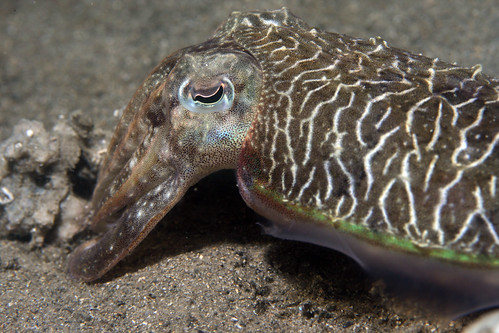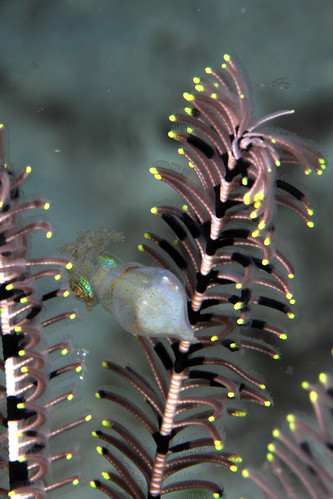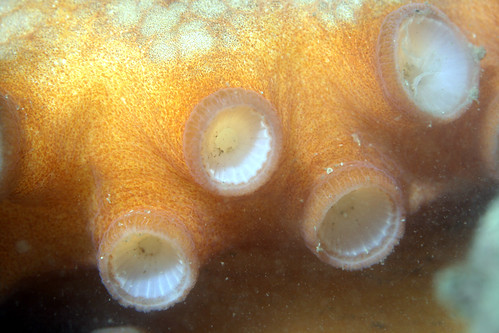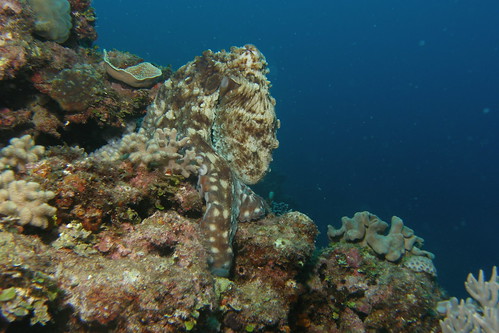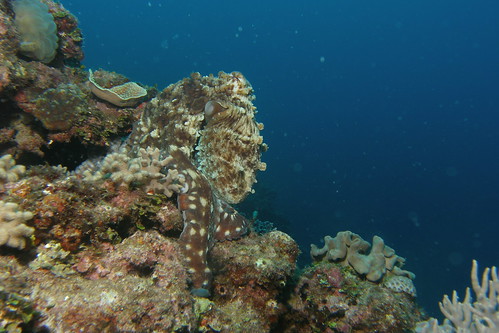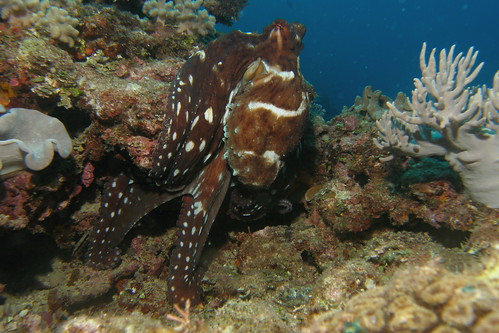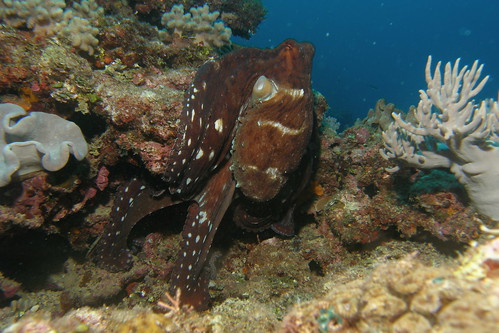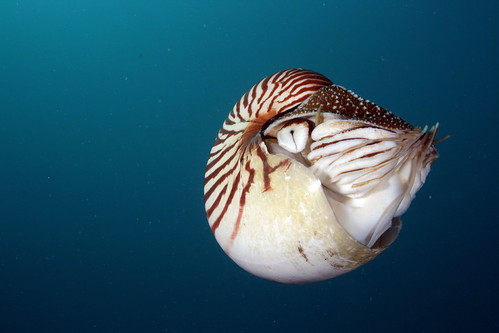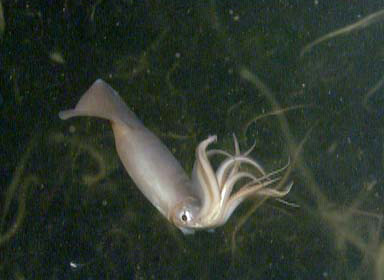I was planning on writing an article about cephalopod statocysts (and I still am; I've just had trouble deciding which pieces of research I want to cover and which I want to leave out) to continue on the theme of cephalopod sensory systems. I've stumbled upon a line research that I just had to blog about, though, so I'm putting off the statocyst post even further. The research in question is a series of studies by
The Octopus Group at the Hebrew University of Jerusalem on the biomechanics and neural control of reaching movements of octopuses. I read this research some months ago (before I was blogging,) and I was reminded of it while watching Twister (the resident
E. dofleini at the Niagara Falls Aquarium) groping about in his enclosure. I noticed that, as he moved his arms about, the movements almost always started with a bend near the base of the arm, which traveled out to the tip, becoming sharper and moving faster as it proceeded. It looked for all the world like the way a wave travels through water (or, more geek-ily, the way one imagines spontaneous activity propagating in a spatially extended nervous system.) The series of studies I will talk about here shows that this is generally the case, and characterizes the way that this happens with some detail, although we still do not know this system in nearly as fine detail as we know the vertebrate neuro-muscular system. I'm getting ahead of myself, though.
Why do we care about the details of how octopuses move their arms? First, it's just plain cool - who, upon looking at an octopus moving, hasn't wondered how it can possibly keep track of all those arms? Second, the octopus arm provides a unique model nervous system for a few reasons. It is a
muscular hydrostat - that it, having no bones, it is a system of muscles that run perpendicularly to each other that maintain a roughly constant total volume; this property of an octopus arm allows it to function like a very flexible vertebrate limb because the muscles can pull against each other to form temporary, semi-rigid structures that allow the arms to bear weight. As such, it is a novel motor system (in terms of research, that is,) with most of the well-characterized motor systems we know of (ie. human, primate, reptile, etc.) are composed of skeletal muscles, which pull against bones. Besides this, the task of coordinating the movement of eight almost infinitely flexible arms is a herculean task in terms of neural processing, and it would be very informative (as well as a triumph of systems neuroscience) to understand how this is done. It has been thought, since the early days of octopus neuroanatomy, that much of the movement of the octopus's arms (and probably those of other cephalopods) is encoded in the nervous system of the arms rather than in the central nervous system (Graziadei, 1971). This is evidenced by the fact that there is no straightforward representation of the arms in the brain of the octopus,
as there is in humans and most other vertebrates, as far as we know, and so it is unlikely that fine motor control comes from the central nervous system. Supporting the importance of the distributed nervous system of the arms is its incredible scale: the nervous system of the arms is much larger than the central nervous system of octopus, containing around 2/3 of all of the neurons in the animal. The octopus arm, then, is a unique example of a highly complex, distributed motor system that stands in contrast to the centrally controlled motor systems we are most familiar with. As with almost every topic in comparative neuroscience (I'm a big sucker for it), I think that the octopus motor system is important because by understanding it, we will understand more about vertebrate nervous systems; that is, we will (pretending for a moment that we could actually solve both systems) understand which features of them are critically related to the specifics of vertebrate and invertebrate neural functioning, physiology, development, and ecology. We would come closer to understanding why each system evolved the way it evolved. Finally, we would exercise our tools of modeling neural computation in a way that would allow us to figure out how generalizable they are. My final verdict: this is a good thing to study.
So now you're bored. You want to hear about some research! Well, I won't disappoint; at least, I hope I won't. We'll start with Gutfreund et al. (1998), one of the early papers out of this research group, which kicked off this line of research by examining the neuromuscular dynamics of octopus reaching movements. I should note that (presumably for simplicity,) this group generally only studies reaching movements in a single arm - it is not know exactly how their findings might relate to more complicated movements, including those involving multiple arms. As a disclaimer I am going to leave out description of a large portion of their study, which I encourage you to read in full, for my own convenience, and only present the results that I think are most relevant to the topic at hand.
This authors in this study used
electromyography (a method of measuring the electrical activity of muscles) in
O. vulgaris to determine how arm muscles are activated in sequence to produce octopus reaching movements. Briefly, they put electrodes through two points in a single arm of their (anesthetized) test animals, then allowed the animals to wake up and elicited reaching movements by tempting the octopus with either a crab or a target that was associated with food. They videotaped the reaching movement, which allowed them to compare the electromyogram to the behavior of the octopus. Reproduced below is their first figure, showing the gross cross-sectional anatomy of the octopus arm, as well as their electrode placement:
The white arrows indicate the position of the electrode, which is the white line running through the muscle. The striated outer portions of the arm are the muscle, and the round shape in the middle is the nerve cord of the arm.
They found that reaching arm movements usually start with a sharp bend near the base of the arm, which travels outwards until it reaches the tip, accelerating somewhat throughout the extention and then slowing as the arm reaches its target. Here's a series of images showing the behavior:
The authors found that this type of arm extension occurs virtue of a propagating wave of muscle contraction traveling down the arm, from the base to the tip. Shown here are examples of the type of data they used to confirm this:

The left panel shows two electromyograms from a single trial, the top one from the electrode nearer to the arm tip, and the bottom one nearer to the base of the arm. The arrows indicate when the bend in the arm reached each electrode. As is apparent, neuromuscular activity at the proximal site started earlier than that at the distal site, coinciding approximately with the timing of the movement of the bend in the octopuses arm. The graph shows the correlation between the lag in the electromyogram record between the two sites and the time it took for the bend in the arm to move between the two sites. It's clear that the propagation of the wave of electrical activity down the arm is highly correlated with the motion of the arm. The authors continue on to characterize some of the properties of these arm movements in more detail and propose a mathematical model for the movement of the octopus arm, but I'll leave those results out, here. I recommend this article for it's methodological clarity - too seldom do authors take such pains to make their method so clear and so thoroughly address their research question.
Moving on, the same reearch group (with a different first author) published a paper in Science describing their experiments with isolated arm preparations (Sumbre et al. 2001). This is where it gets really interesting to me, because this experiment really gets at the distinction between central and peripheral motor control. The authors made their preparations by either denervating one arm of an octopus that had already been decerebrated (a procedure somewhat akin to an octopus lobotomy) by severing its connection to the brain, or by severing an arm completely. They then attached the base of the arm to a surface, and stimulated the nerve cord at the base of the arm. It was found that, in a large percentage of cases (46%, to be exact,) the movement resembled the reaching movement seen in an intact animal. The figure below (taken from the paper) shows the reaching movement of a normal animal (on the left) and that elicited by stimulating the nerve cord of a denervated arm in a decerebrate animal:

Importantly (for reasons I'll explain in a second,) it appears that the arm movements were initiated, but not sustained by the stimulation. We can tell the difference because the "reaching" movement continued through to completion even when it began slightly after the experimenters stopped stimulating the arm. This shows that the brief stimulation started a motor process that was maintained by the intrinsic neuromuscular system of the arm. The authors also found that similar movements could be elicited in amputated arms by "tactile stimulation of the skin or suckers." After a brief analysis of the kinetics of the evoked movements, the authors conclude that they, like those of intact animals, are caused by a propagation of muscle activity down the arm.
The authors' conclusion:
"The division between the central and
peripheral levels of the octopus motor control
system resembles the hierarchical organization
of motor control systems in other
invertebrates and vertebrates, even
though in the octopus it uniquely serves as
an important component in a goal-directed
voluntary movement rather than in rhythmical
or reflexive behaviors."
The peripheral nervous system of the octopus appears to play a much greater role in the programming of movement that does the peripheral nervous system of vertebrates (which can only independently control simple reflexes and some other involuntary movements like peristalsis), even to the extent that it can execute complex movements (like reaching as if to grasp) all by itself. That propagating wave of muscle activity isn't coordinated by the central nervous system, like coordinated movements are in humans; rather, it's coordinated by the nervous system intrinsic to each arm. This is convenient for the octopus because it means that it generally does not need to keep track of its arms (that is, it's central nervous system doesn't have to spend a lot of resources monitoring and controlling them) because they largely take care of themselves. It's a good solution to the problem of having a large number of incredibly flexible appendages.
The exact extent of the arm's abilities to coordinate their own motor activity, as well as activity between arms, remains to be uncovered by more and more detailed experiments on a variety of types of movement, but the general conclusion seems pretty solid to me, and fits nicely with what we know about the neuroanatomy of the octopus. It would also be interesting to see the results of similar studies in other cephalopods. I have a sneaking suspicion that one could relate the extent of the peripheral nervous system's "motor autonomy" from the central nervous system to the complexity of arm movement required by a given species' lifestyle. It would be a neat idea to explore (if I had a laboratory on the Italian coast and a million-dollar grant to study squids. I can dream, right?)
There's one more article I wanted to cover here, but I don't have time at the moment, and I want to get this up tonight. It's by the same group, and it applies what the previous studies showed to explain the way that octopuses retract their arms after they have grasped their target. Hopefully I'll have a shorter post on that before the end of the weekend.
As always, thanks for reading!
 Sumbre, G. (2001). Control of Octopus Arm Extension by a Peripheral Motor Program Science, 293 (5536), 1845-1848 DOI: 10.1126/science.1060976
Sumbre, G. (2001). Control of Octopus Arm Extension by a Peripheral Motor Program Science, 293 (5536), 1845-1848 DOI: 10.1126/science.1060976
Gutfreund Y, Flash T, Fiorito G, & Hochner B (1998). Patterns of arm muscle activation involved in octopus reaching movements. The Journal of neuroscience : the official journal of the Society for Neuroscience, 18 (15), 5976-87 PMID: 9671683
Graziadei, P.P.C. (1971). The nervous system of the arms. pp. 44-61 in Young, J.Z. The Anatomy of the Nervous System of Octopus vulgaris. Oxford : Clarendon Press.
